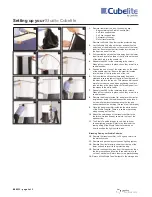
13
The extended use under special weather conditions may reduce system performance and result
in partial fogging and problems of condensation on the inner visor. In this case, remove the inner
visor from the helmet visor and dry it with dry and lukewarm air to restore system efficiency.
Intense sweating /breathing, the use under particular weather conditions (low temperatures,
and/or high humidity and/or sudden changes in temperature or heavy rain) and intense and pro-
longed use may affect the performance of the system and cause the fogging or formation of con-
densation on the inner visor.
In such cases, after using the helmet and to restore the system efficiency, remove the inner visor
from the helmet visor and let it dry with dry and lukewarm air. The same procedure must be applied
to the helmet, in order to dry out humidity in case it has formed up as a consequence of the con-
ditions described above.
2 PINLOCK
®
INNER VISOR DISASSEMBLY
2.1 Remove the visor equipped with the Pinlock
®
inner visor.
2.2 Widen the visor and release the Pinlock
®
inner visor from the pins (Fig. 7).
2.3 Release the visor.
MAINTENANCE AND CLEANING
Remove the Pinlock
®
inner visor from the visor. Using a damp and soft cloth, gently clean it with
neutral liquid soap. Remove the soap under running water.
Dry the inner visor with dry and lukewarm air without wiping it.
To keep the features of the inner visor in good conditions over time, let the helmet dry in a venti-
lated and dry place with the visor open after use.
Keep it away from heat sources and store it in a place away from direct light.
• WIND
PROTECTOR
This accessory allows improved helmet performance under certain conditions of use.
The Wind Protector reduces unpleasant infiltrations of air under the chin.
See Fig. 9 for the assembly and disassembly.
•
REAR EXTRACTOR (Fig. 10)
The rear extractor allows warm air to emerge, giving excellent heat dispersion.
•
FRONT PART TOP VENTILATION SYSTEM (Fig. 11)
The open ventilation system allows conveying air directly to the visor, to reduce visor fogging
and formation of condensation.
A) Closed
B) Open
•
FRONT PART LOWER VENTILATION SYSTEM (Fig. 12)
The ventilation systems allows conveying air directly to the visor to improve air circulation:
A) Closed
B) Open
•
TOP VENTILATION SYSTEM (Fig. 13)
The two top air intakes allow conveying air into the shell, independently from the VPS position:
A) closed
B) open
Summary of Contents for X-603 Series
Page 50: ...50...
Page 51: ...51 E v...
Page 52: ...52...
Page 53: ...53 4A 4B 4C 5A 5B 5A 5B RACING EXPERIENCE...
Page 55: ...55 2 PINLOCK 2 1 Pinlock 2 2 Pinlock 7 2 3 Pinlock Wind Protector 9 10 11 B 12 B 13...
Page 56: ...B1 B2 B1 B2 A1 B2 B1 A2 Fig 2 Fig 3 Fig 1 Fig B Fig C Fig A...
Page 57: ...Fig 5A Fig 4B Fig 4C Fig 4A Fig 5B...
Page 58: ...Fig 9 Fig 10 Fig 6 Fig 8 Fig 7 MIN MAX...














































